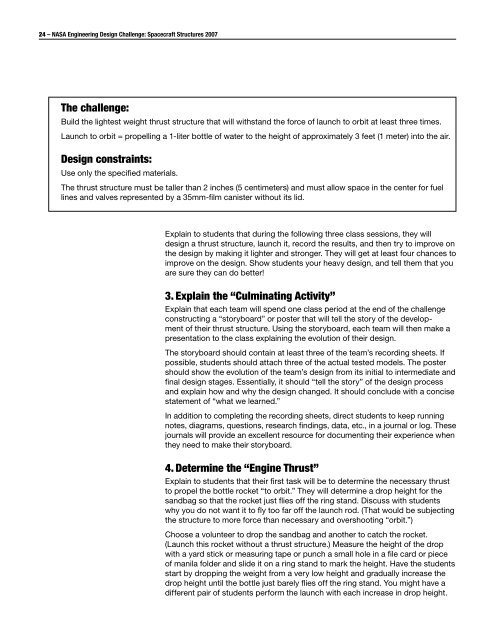Spacecraft Structures pdf - ER - NASA
Spacecraft Structures pdf - ER - NASA
Spacecraft Structures pdf - ER - NASA
- No tags were found...
Create successful ePaper yourself
Turn your PDF publications into a flip-book with our unique Google optimized e-Paper software.
24 – <strong>NASA</strong> Engineering Design Challenge: <strong>Spacecraft</strong> <strong>Structures</strong> 2007The challenge:Build the lightest weight thrust structure that will withstand the force of launch to orbit at least three times.Launch to orbit = propelling a 1-liter bottle of water to the height of approximately 3 feet (1 meter) into the air.Design constraints:Use only the specified materials.The thrust structure must be taller than 2 inches (5 centimeters) and must allow space in the center for fuellines and valves represented by a 35mm-film canister without its lid.Explain to students that during the following three class sessions, they willdesign a thrust structure, launch it, record the results, and then try to improve onthe design by making it lighter and stronger. They will get at least four chances toimprove on the design. Show students your heavy design, and tell them that youare sure they can do better!3. Explain the “Culminating Activity”Explain that each team will spend one class period at the end of the challengeconstructing a “storyboard” or poster that will tell the story of the developmentof their thrust structure. Using the storyboard, each team will then make apresentation to the class explaining the evolution of their design.The storyboard should contain at least three of the team’s recording sheets. Ifpossible, students should attach three of the actual tested models. The postershould show the evolution of the team’s design from its initial to intermediate andfinal design stages. Essentially, it should “tell the story” of the design processand explain how and why the design changed. It should conclude with a concisestatement of “what we learned.”In addition to completing the recording sheets, direct students to keep runningnotes, diagrams, questions, research findings, data, etc., in a journal or log. Thesejournals will provide an excellent resource for documenting their experience whenthey need to make their storyboard.4. Determine the “Engine Thrust”Explain to students that their first task will be to determine the necessary thrustto propel the bottle rocket “to orbit.” They will determine a drop height for thesandbag so that the rocket just flies off the ring stand. Discuss with studentswhy you do not want it to fly too far off the launch rod. (That would be subjectingthe structure to more force than necessary and overshooting “orbit.”)Choose a volunteer to drop the sandbag and another to catch the rocket.(Launch this rocket without a thrust structure.) Measure the height of the dropwith a yard stick or measuring tape or punch a small hole in a file card or pieceof manila folder and slide it on a ring stand to mark the height. Have the studentsstart by dropping the weight from a very low height and gradually increase thedrop height until the bottle just barely flies off the ring stand. You might have adifferent pair of students perform the launch with each increase in drop height.
















